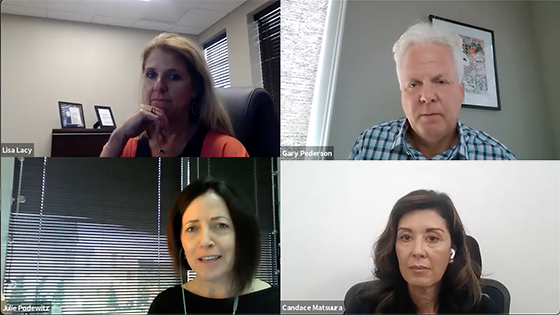Hiring and retaining good employees was already one of seniors housing operators’ top challenges before the COVID-19 pandemic struck.
Despite the many new problems that the outbreak presented, many in the seniors housing industry saw a potential silver lining: With so many losing jobs in the hospitality sector, among others, would this be a chance for operators to snatch up those workers?
Unfortunately, it appears that did not come to fruition.
“When the pandemic started and there were so many layoffs in the hospitality industry, I thought ‘Here we go. We’re going to have this influx of people into senior living. This is really going to help our staffing challenges,’” said Lisa Lacy of Discovery Senior Living. “A year-and-a-half later we’re seeing the opposite of that. We’re competing with organizations that we didn’t compete with before. It’s not the community down the street. It’s fast food, Amazon, companies like that.”
Lacy’s comments came during a webinar titled “Invigorating the Seniors Housing Workforce: Strategies to Inspire, Engage and Retain Talent” held July 22. Other panelists included moderator Gary Pederson of MatrixCare, Candace Matsuura of Westmont Living and Julie Podewitz of Vitality Living.
Pederson echoed Lacy’s concerns about new competition.
“There are safety concerns and new employees are worried. We have continued government unemployment programs that are keeping people at home, which has reduced the number of active participants in the workforce. With the opportunities in retail so high, with minimum wage going up, now we find our providers are competing against fast food and Amazon to compete for the same hourly wage we hope to attract to our industry.”
Podewitz said Vitality is getting plenty of applicants. The problem is that oftentimes they never show up.
“Ghosting is a major challenge. Ghosting the interview, post-interview, and even after an offer’s been put in.”
What’s more, with a team that’s stretched thin, existing employees don’t have the time to properly train new hires, noted Matsuura.
“Their bandwidth is becoming tighter and shorter. We’re not able to really provide that long-term onboarding and give them the attention that they need.”
Solutions require inventiveness
Several of the panelists noted that operators have to shift their thinking on hiring in a variety of ways, selling their company to potential recruits the same way they sell to potential residents.
“All of a sudden recruiting for residents and recruiting for candidates are on almost equal footing,” said Pederson.
Lacy noted that Discovery has implemented short-term solutions such as sign-up bonuses and increased starting wages. In the long-term, though, she suggested “looking at it more holistically and casting a wide net.”
“Simply posting a job on Indeed is not enough. We have to get our job messaging out. We’re using social media now more for job searches, which has helped with increased applicant flow. A lot of the candidates go to Facebook or use LinkedIn.”
“We’ve worked on making our application process simpler, more technology driven and mobile friendly,” continued Lacy. “We have to follow up very quickly. We can’t sit on candidates for days on end anymore. We’re texting, emailing, calling — whatever method works best to communicate with the candidate.”
Podewitz said Vitality tries to keep the time commitment of an application extremely short, the same way the sales team tries to get a resident through the sales pipeline quickly.
“We have a prompt and we make it simple. Then we follow up with a customized message with feeling and emotion — we really care about you, we really want to talk to you. We hit it on every level very quickly, many times without hardly speaking to them. You have to engage technology at every stage of the process to stay competitive.”
Regardless of what changes are made, all operators should be looking very closely at their methods for recruiting and adjusting to the new world, concluded Matsuura.
“We really need to shift from that post-and-pray mentality, where we think we’re going to get all these qualified candidates coming to the door. We need to look at how we market to the talent that we need in our building.”
To view the full webinar, click here.
— Jeff Shaw

